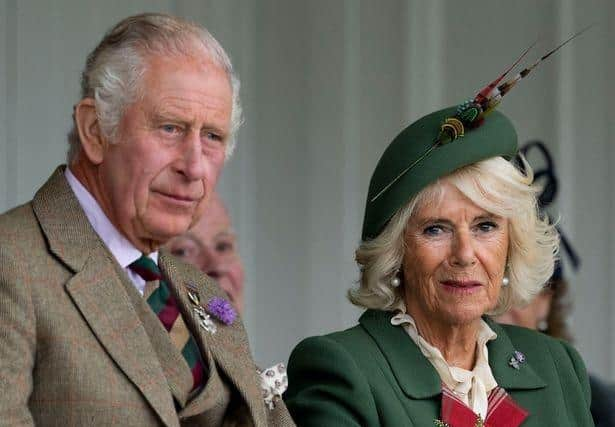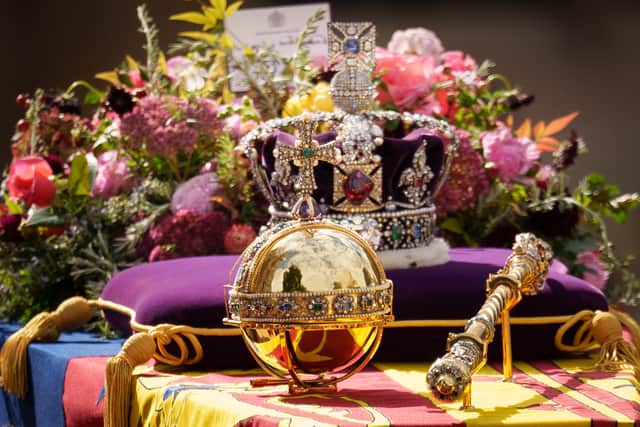Which crown jewels will be used in King Charles’ coronation? Types used - how much they are worth
and live on Freeview channel 276
Buckingham Palace has confirmed which crown jewels will be used during the coronation of King Charles.
The Queen Consort will use an ivory sceptre during the ceremony following speculation it might be dropped from the ceremony. Camilla will be crowned when Charles is enthroned as the new monarch during an ancient ceremony featuring deeply symbolic objects representing the royal duties and responsibilities of the sovereign and his wife.
Advertisement
Hide AdAdvertisement
Hide AdIt is understood she will hold a gold sceptre surmounted by a cross and a second staff made of ivory and topped by a dove, during the coronation being staged at Westminster Abbey on Saturday (6 May).
There were reports the sceptre would not be used given the Prince of Wales’s campaign to stop the illegal trafficking of animal parts, like rhino horn and elephant ivory, through his umbrella organisation United for Wildlife. Last August, William hailed a “landmark” illegal wildlife trade sentencing that saw a man jailed for five years for conspiring to traffic millions of dollars worth of rhinoceros horns and elephant ivory.


Britain is at the forefront of global conservation efforts after the Ivory Act 2018 brought in, from 6 June last year, a near-total ban in the dealing of items containing elephant ivory. The ivory sceptre is part of the crown jewels and regalia held in trust by the monarch for the nation.
They form part of the Royal Collection and have traditionally been held at the Tower of London which is managed by Historic Royal Palaces. Kathryn Jones, senior curator of decorative arts, at the Royal Collection Trust, speaking about previous coronation ceremonies, said: “The Queen is also presented with two sceptres…this is again this symbol of temporal power – so with the cross. And the second sceptre, like the King’s sceptre, has the dove on the top, (and is) symbolic of equity and mercy.
Advertisement
Hide AdAdvertisement
Hide Ad“And this one the wings are folded, rather than spread, it has the same symbolism – so it’s the Holy Spirit.”
Which crown jewels will be used in coronation?
The priceless array of coronation regalia from the Crown Jewels which will be used during the religious service in the Abbey has also been confirmed.
It will include the Sovereign’s Orb, the Golden Spurs, bracelets known as Armills, two maces, five symbolic swords, the Sovereign’s Ring, the Sovereign’s Sceptre with Cross and the Sovereign’s Sceptre with Dove.
Camilla will be crowned, as previously announced, with the modified Queen Mary’s Crown, but she will also hold the Queen Consort’s Rod with Dove – despite the controversial rod being made from ivory.
Advertisement
Hide AdAdvertisement
Hide AdThe piece is said to symbolise equity and mercy, and the dove, with its folded wings, represents the Holy Ghost.
Camilla will also hold the Queen Consort’s Sceptre with Cross, which originally made for the coronation of Mary of Modena, Queen Consort of James II, in 1685 and is inlaid with rock crystals.
As part of the proceedings, she will receive the Queen Consort’s Ring – a ruby in a gold setting made for the Coronation of King William IV and Queen Adelaide in 1831, and used by three further Queens Consort – Queen Alexandra, Queen Mary, and the Queen Mother.
As previously announced, Charles will be crowned with the 17th century St Edward’s Crown which has been resized to fit his head.
Advertisement
Hide AdAdvertisement
Hide AdHe will switch it for the lighter Imperial State Crown at the end of the ceremony as is the custom.
The original coronation regalia was destroyed by order of parliament after King Charles I was executed during the Civil War, which briefly led to a republic. It was broken up and melted down into gold coins, with the jewels sold.
The ivory staff which Camilla will use was made in 1685 for Queen Mary of Modena, the wife of James II, who was the first Queen Consort to participate in a coronation ceremony following the restoration of the monarchy in 1660. A Buckingham Palace spokeswoman said: “As with any historical collection of its size, it is to be expected that the Royal Collection includes items that contain ivory as this reflected the taste at the time.”


History of the crown jewels
The British crown jewels are the country’s most precious treasures and includes the sacred Coronation Regalia used during the crowning of a new monarch. Comprising of more than 100 objects and over 23,000 gemstones, the crown jewels are priceless.
Advertisement
Hide AdAdvertisement
Hide AdThey are held at the Tower of London, were they have been protected since the 1660s. They include the Soverign’s sceptre and orb and St Edward’s Crown, all of which date to 1661.
One of the oldest objects in the crown jewels is the Coronation Spoon, which traces back to the 12th century. It is used for the anointing the sovereign with holy oil.
The British coronation regalia are the only working set in Europe. The use of crown jewels in the UK dates back to the arrival of Christianity in the Early Middle Ages and the holy relics were kept at Westminster Abbey.
However aside from the Coronation Spoon, the oldest of the current crown jewels date back to just 350 years. This is due to the medieval and Tudor regalia being melted down or sold off following the monarchy was abolished in 1649.
Advertisement
Hide AdAdvertisement
Hide AdSt Edward’s Crown and the Soverign’s sceptre and orb date back to the crowning of Charles II in 1661.
Have the crown jewels ever been stolen?
The original English crown jewels were melted down or sold off following the abolishment of the monarch in 1649 at the end of the civil war. But since the restoration, the crown jewels have been safely held at the Tower of London.
However across the Irish sea, the Irish Crown Jewels were stolen from Dublin Castle in 1907 in a scandalous heist which has yet to be solved. The relics whereabouts remain unknown to this day.
How much are the crown jewels worth?
The British crown jewels are said to be priceless. Unofficial valuations estimate that the objects in Tower of London are worth between £3 billion and £5 billion.
Comment Guidelines
National World encourages reader discussion on our stories. User feedback, insights and back-and-forth exchanges add a rich layer of context to reporting. Please review our Community Guidelines before commenting.